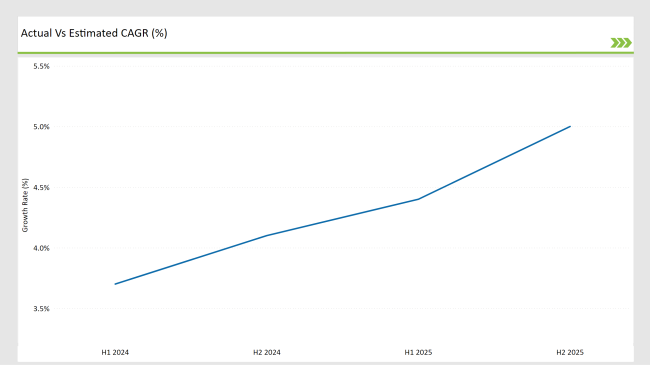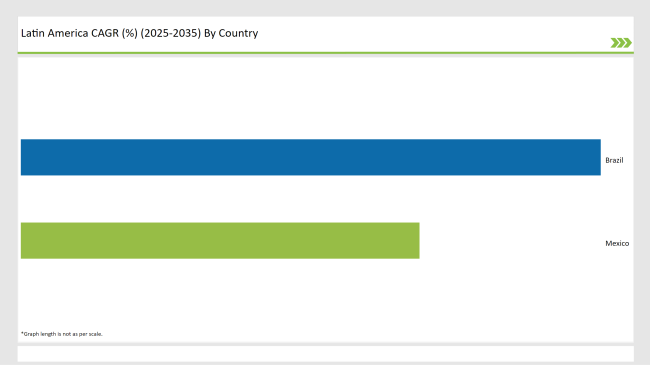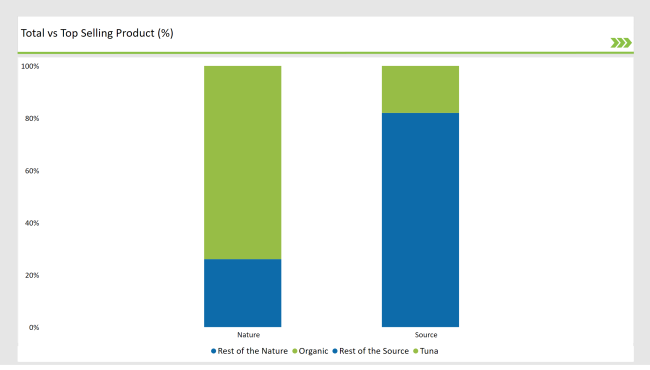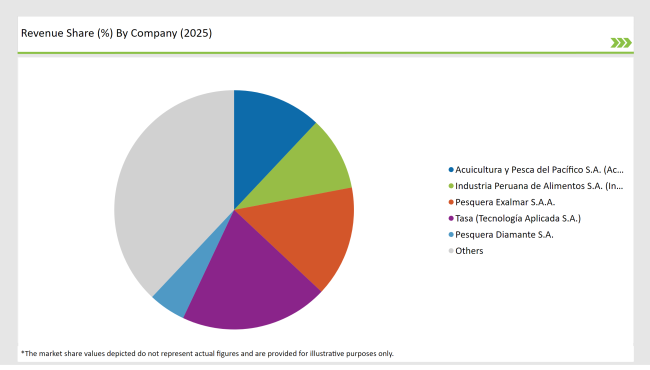The Latin America fish meal market is set to grow from an estimated USD 3,676.2 million in 2025 to USD 5,897.5 million by 2035, with a compound annual growth rate (CAGR) of 4.8% during the forecast period from 2025 to 2035.
| Attributes | Value |
|---|---|
| Estimated Latin America Industry Size (2025E) | USD 3,676.2 million |
| Projected Latin America Value (2035F) | USD 5,897.5 million |
| Value-based CAGR (2025 to 2035) | 4.8% |
Latin America’s aquaculture industry is on the rise due to the increased tendency of the consumers toward seafood and the consumption of protein from sustainable sources. Fish meal is an essential component in aquaculture.
It is the primary source of nutrients, such as high-quality protein and omega-3 fatty acids, that are needed for the growth and health of the fish. Fish meal is a very important part of modern fish farming and therefore the demand for fish meal scales up together with aquaculture production to meet market needs.
Latin America, especially Peru and Chile, has the main place in the world fish meal producer, taking advantage of the abundant marine resources. It is the fish meal of the region that is the one in high demand at the international level, especially in Asia and Europe, where there is a growing demand for the high-quality animal feeds.
This strong export market not only helps local economies but also shapes and drives the need for sustainability in the fishing sector. Latin American fish meal producers have the best chances to take advantage of these business opportunities as long as international demand for fish meal stays high.
The table below provides a detailed comparative assessment of the changes in the compound annual growth rate (CAGR) over six months for the base year (2024) and the current year (2025) specifically for the Latin America fish meal market.
This semi-annual analysis highlights crucial shifts in market dynamics and outlines revenue realization patterns, providing stakeholders with a more precise understanding of the growth trajectory within the year. The first half of the year, H1, covers January to June, while the second half, H2, spans July to December.

H1 signifies period from January to June, H2 Signifies period from July to December
For the Latin America fish meal market, the is predicted to grow at a CAGR of 3.7% during the first half of 2024, with an increase to 4.1% in the second half of the same year. In 2025, the growth rate is anticipated to slightly increase to 4.4% in H1 and is expected to rise to 5.0% in H2.
This pattern reveals a decrease of 20 basis points from the first half of 2024 to the first half of 2025, followed by an increase of 20 basis points in the second half of 2025 compared to the second half of 2024.
Expanding Horizons: The Versatile Applications of Fish Meal
Moreover, many other applications of fish meal have been discovered, thus extending its market beyond the conventional use for animal feed, which is the one that the industry has developed over the years. Fish meal, in its turn, is being explored in the pharmaceutical sector and is seen as a source of omega-3 fatty acids and proteins that are good for the heart and are considered to be a wellness-promoting ingredient in dietary supplements.
In addition, fish meal has been mentioned in the organic fertilizer sector because it is a natural and eco-friendly product that is rich in nutrients that help the soil to become more fertile and the plants to grow healthier. This course shifted the mode of production for the fish meal by creating new revenue channels for the raw material producers.
However, it should be pointed what is more important is the fact that this mode fits the demand of the people who want natural and sustainable products. The sustainability in the health and environmental sectors has long been the source of who, where and what to trust; therefore, the potential of fish meal that is derived from the industries that seek to become the bearer of the standards is enormous.
Fish Meal Innovations: Enhancing Digestibility and Nutrient Absorption
The use of fish meal in newly constructed probiotic fish and livestock feeds is a step forward in changing the aquaculture and livestock industries. The new formulations are adapted to the needs of feed efficiency; therefore, the animals get the proper nutrition with minimal waste.
In the process of adding, fish meal, in which the best way to feed pigs and cattle is the one which is rich in protein, fat, and omega, feed additives can be used that help with digestion and the absorption of nutrients, thereby maximizing the benefits of fish meal.
As businesses are hunting for better means to meet protein-rich food demands, fish meal finds its way into the feed mixture more often since it is the most sought-after raw material in sustainable animal husbandry and medicine.
The following table shows the estimated growth rates of the top two markets. These countries are set to exhibit high consumption, recording high CAGRs through 2035.

Brazil is in a strategic position as a key player in the fish meal market globally mainly due to its closeness to the main international markets, especially in Asia and Europe, where the first interest is in high-quality fish meal.
The potential for this export makes it a strong incentive for local producers to increase the production capacity so that they can satisfy both domestic and international markets. Also, the introduction of technological advancement in the feed formulation and feed processing are such that fish meal production in Brazil is being revolutionized.
For example, process like the new extraction methods and the addition of vitamins have the benefit of lowering costs and increasing the fish meal high efficiency and making it easier for feed manufacturers to choose it. These steps not only maximize the production process but also meet the criteria of the growing sector, which is sustainability and the nutritional value in animal feeds.
The result is that Brazil has placed itself in the perfect position to not only meet the local demand with fish meal but also to take advantage of the export route driving the demand for fish meal in turn.
The Mexican government's backing of aquaculture and livestock sectors is the main thrust that pushes up fish meal demand. To achieve this, the government implements a variety of programs such as subsidies, research funding, and financial regulations to improve production and sustainability in the industries.
This inviting framework for legislative productivity motivates the! production! of fish meal by the local and foreign investors, assuring the state of the market's steady supply. Meanwhile, the livestock sector especially poultry and swine- has been gradually adding fish meal to its feed formulations in order to boost the protein content and better weight gain of the animals.
As consumer interest heightens, producers are more on the lookout for top-quality ingredients which inceptively begetfeed efficaciousness and eternity frailty. The combination of the government backing and the hike in the livestock sector indeed wholesales fish meal and valorizes it as a significant part of Mexico's agricultural setting.
% share of Individual categories by Nature and Source in 2025

Country-wise fisheries and aquaculture operators are being supported through local sourcing schemes in Latin America, which in turn are promoting the use of organic fish meal produced in the region. This approach cuts down transportation carbon footprints while at the same time, it supports local economies by the purchase of fish and aquaculture products from the region.
Producers are provided with the opportunity to choose the locally sourced organic fish meal over the ones from other regions and at the same time, they should receive benefits like decreasing the cost of transport which the trend would bring on. In addition, the ongoing investment in a research and development effort is inspiring organic alternative aquaculture practices through the spearhead across the area.
Resources are drained on projects testing the efficient production of organic fish and studies layout the health benefits caused by such fish on the ecosystem and fish farmers which in turn cause improvements in yield and resourcefulness.
The research orientation not only improves the quality of organic fish meal but also acts the role of educational services for producers about the advantages and the practical drive which leads to its diffusion in the market.
Countries in Latin America, particularly Peru and Ecuador, have been the ones to take the lead in the world tuna fish meal market and benefiting from very good export opportunities. The unstoppable trend of increasing demand for fish meal that is high in quality, and mostly from countries in Asia and Europe, leads the local industry to make more fish meal of tuna kind.
The economic growth of these countries will be accompanied by their share of the market as the leaders in the seafood sustainably sourced. At the same time, tuna fish meal is in high demand because of its nutritional benefits.
The presence of protein and fats that are essential in the diet of aqua and livestock species oilmeal has turned it into the natural choice of feed ingredients. The beneficial nutrients in tuna fish feed not only help the fish to grow, but also keep them healthy and hence are preferred by the feed manufacturers who aim at advertising their final products as high quality.
2025 Market share of Latin America Fish Meal Manufacturers

Note: above chart is indicative in nature
The Latin American fish meal market has a moderate level of consolidation and is dominated by companies such as Tasa, Pesquera Exalmar, and Blumar Seafoods, which, with their extensive production capabilities and established distribution networks, lead the industry. They expand on their firm asset networks and sophisticated research and development schemes to keep up the leading edge.
Nowadays they are more concerned about production efficiency than ever before and at the same time are turning to sustainable practices to cope with their environmental footprint. Acuicultura y Pesca del Pacifico and Pesquera Diamante are not only regional market players but are also building customer trust through product specialization and thus their contribution to the market is both growth and diversification.
As per Nature, the industry has been categorized into Organic and Conventional.
As per Based on Application, the industry has been categorized into Animal Feed, Aqua Feed, Poultry, Pharmaceuticals, Dietary Supplement, and Fertilizers.
As per Source, the industry has been categorized into Crustaceans, Crabs, Lobsters, Crayfish, Shrimps, Prawns, Krill, Woodlice, Barnacles, Cyprinids, Tuna, Tilapia, Swordfish, Salmons, Milkfish, Catfish, Trout, Marine Fish, Eels, and Molluscs.
Industry analysis has been carried out in key countries of Brazil, Mexico and Rest of Latin America.
The Latin America fish meal market is projected to grow at a CAGR of 4.8% from 2025 to 2035.
By 2035, the market is expected to reach an estimated value of USD 5,897.5 million.
Local sourcing initiatives in Latin America are gaining traction as countries promote the use of organic fish meal produced within their borders.
Mexico and Brazil are key regions with high consumption rates in the Latin America fish meal market.
Leading manufacturers include Acuicultura y Pesca del Pacífico S.A. (Acuipac), Industria Peruana de Alimentos S.A. (Inper), Pesquera Exalmar S.A.A., Tasa (Tecnología Aplicada S.A.), and Pesquera Diamante S.A..
Explore Similar Insights

Thank you!
You will receive an email from our Business Development Manager. Please be sure to check your SPAM/JUNK folder too.
Chat With
MaRIA